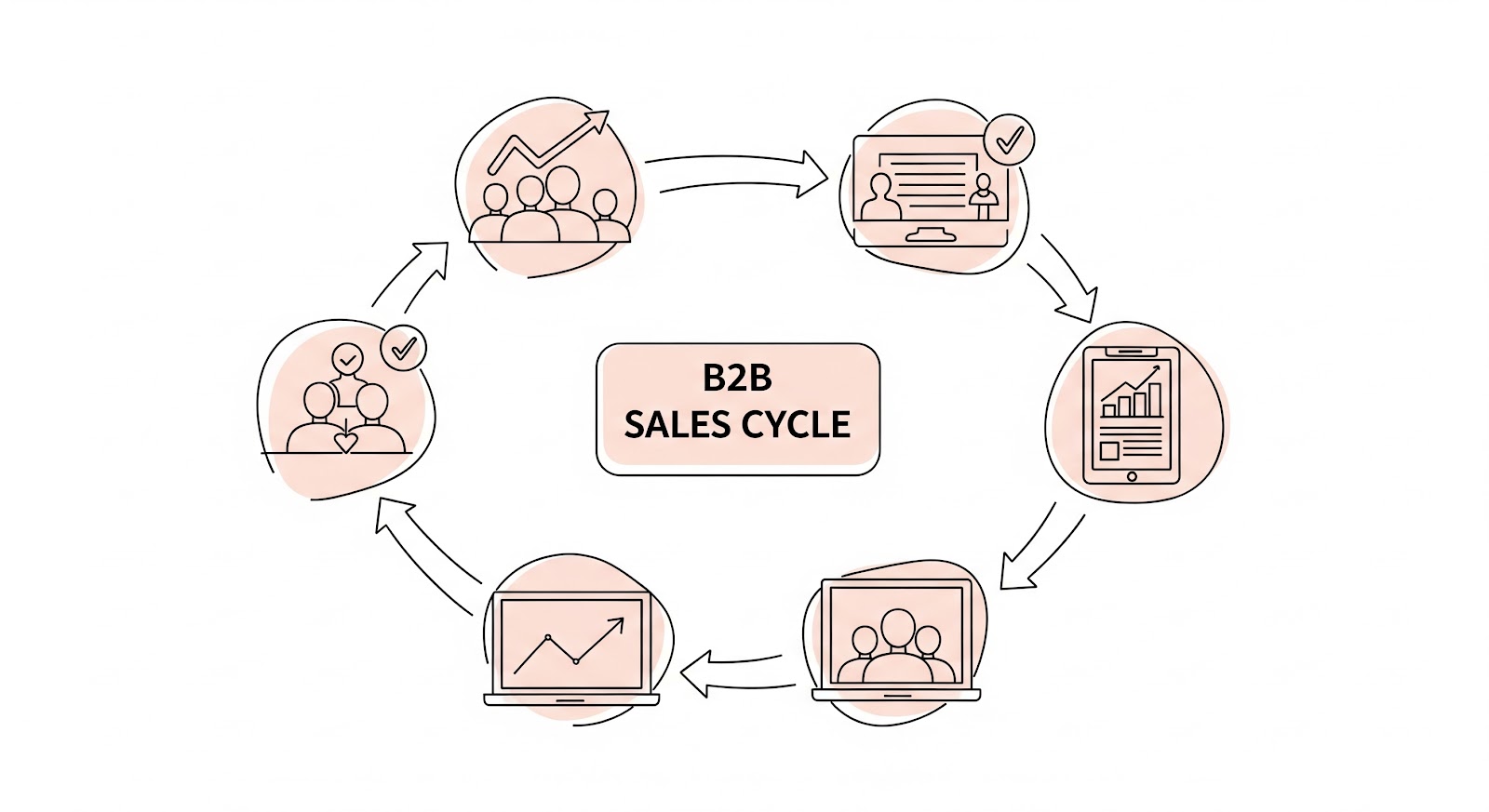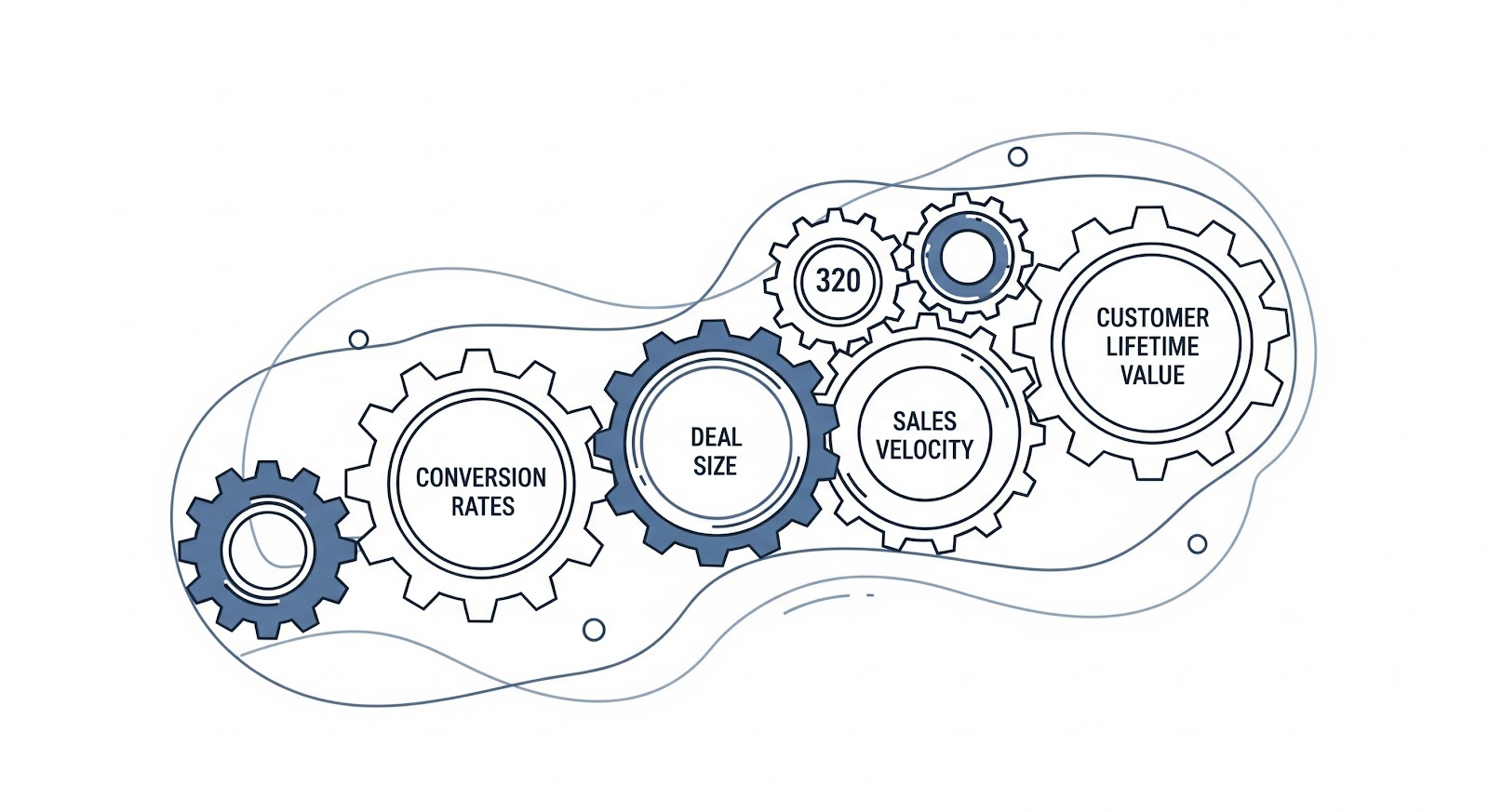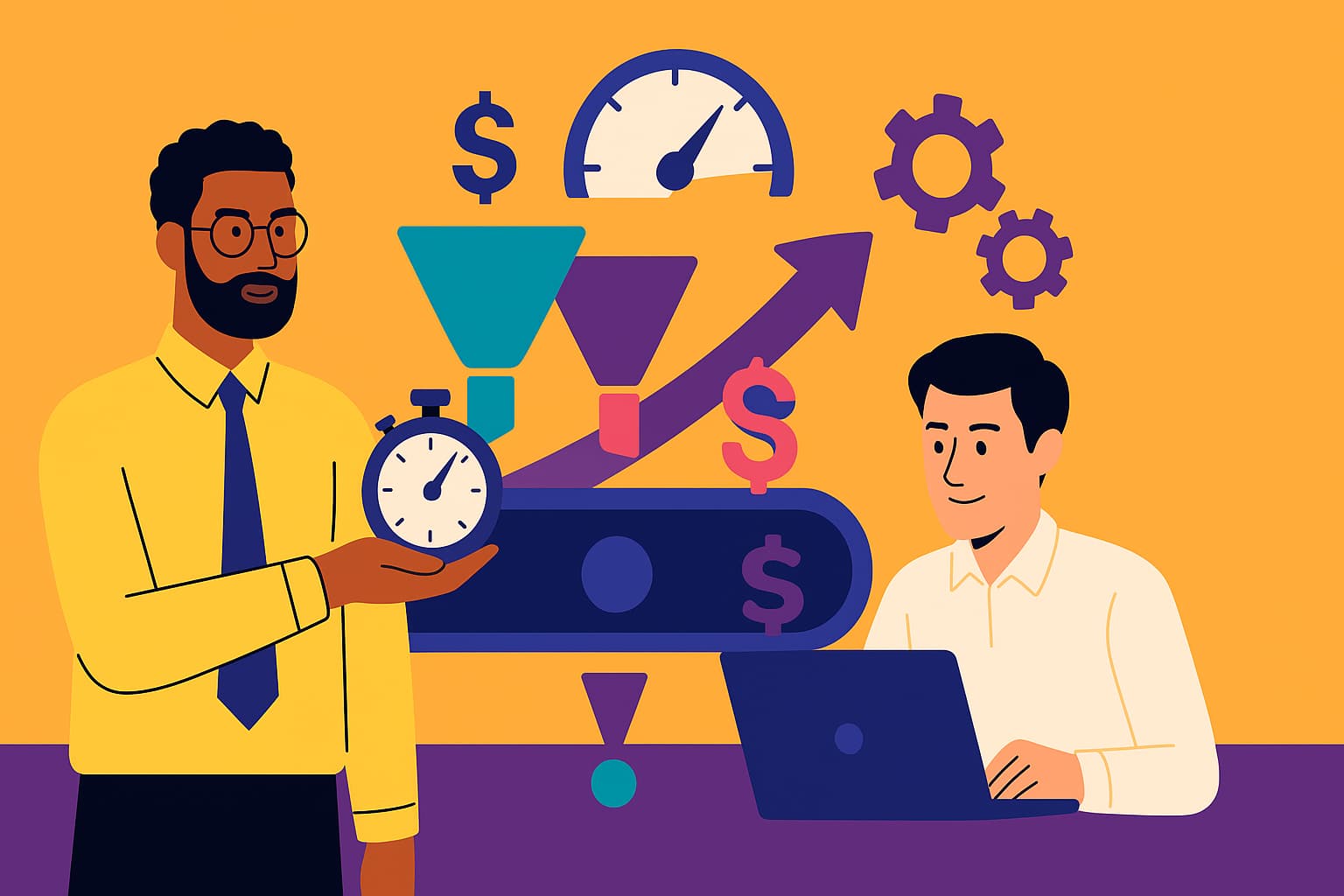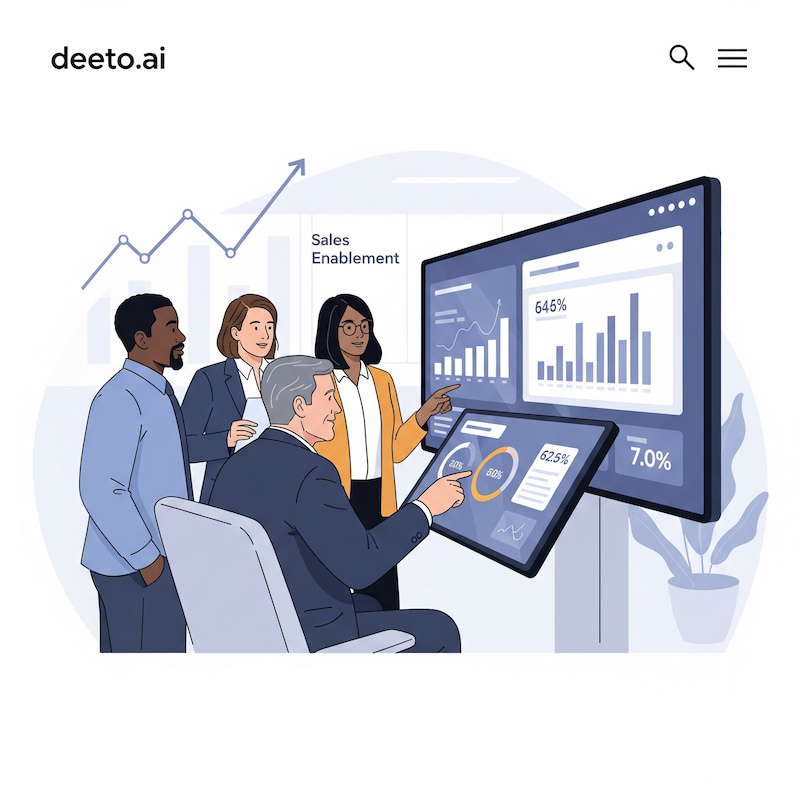Long sales processes drain resources, slow down growth, and frustrate your team. But most sales cycles aren’t long because they have to be. They’re long because of inefficiencies at every stage: unqualified leads, unclear messaging, slow follow-ups, disconnected tools.
The good news? Every stage of the cycle can be optimized. And when you do that, deals close faster and more predictably.
In this guide, you’ll learn practical ways to tighten each stage of your sales process, from prospecting to closing.
What is the B2B sales cycle?
The B2B sales cycle is the step-by-step process your business follows to turn a lead into a paying customer. It usually involves multiple stakeholders, longer timelines, and higher-value deals than B2C sales.
While the exact stages vary by company, most B2B sales cycles include:
- Prospecting
- Qualifying
- Pitching
- Negotiating
- Handling objections
- Closing
- Onboarding
The whole cycle can take weeks or months, depending on your product, deal size, and decision-makers involved. The goal is simple: move the right leads through each stage as efficiently as possible without sacrificing deal quality.
Why it’s so important to understand the B2B sales cycle
Despite having more tools, data, and automation than ever, B2B sales cycles are getting longer, not shorter. 58% of B2B professionals told SaaStr their sales cycles were even longer in 2024.
Why?
- More complex solutions. Buyers aren’t just looking for quick fixes. They want tools that fit into broader ecosystems, which means more questions, more demos, and longer evals.
- Larger buying groups. A typical B2B deal now involves 6 to 10 decision-makers. Getting everyone aligned takes time.
- More buyer research. There’s a flood of content out there. Your prospects are reading reviews, case studies, and competitor comparisons long before they talk to you.
- Budget scrutiny. The economy’s getting tighter, which means buyers are more critical about the purchases they make and sellers have to do extra legwork to create confidence signals.
Longer sales cycles do present some opportunities, though. You have more time to build real trust, position your product as a strategic fit, and fine-tune your sales process to reflect how today’s buyers actually buy.
That’s exactly why I’m writing this article: to help you turn a slow, scattered sales cycle into one that’s efficient, focused, and built to close.
7 stages of the B2B sales cycle (and how to shorten each one)

Shortening the B2B sales cycle requires you to attack friction at every stage. It’s not about rushing the process. It’s really more about removing bottlenecks, aligning with how your buyers make decisions, and keeping momentum from first touch to close.
Let’s break down each stage and how to optimize it.
1. Prospecting
Sellers have a hard time with prospecting because it’s time-consuming and inconsistent. They waste hours chasing the wrong leads by relying on gut instinct or outdated lists. Personalization takes too long, and outreach gets deprioritized when deals in the pipeline heat up. As a result, top-of-funnel activity stalls, as does revenue down the line.
The fix is smarter targeting. Use data enrichment tools to build accurate, up-to-date lead lists that match your ICP. Layer in firmographic filters like company size, tech stack, and recent funding to prioritize high-fit accounts.
Then, let AI do the heavy lifting.
Use AI tools to write first-touch emails, score leads based on intent signals, and predict which prospects are most likely to convert (lead scoring). The goal isn’t to automate the human out of prospecting. It’s to give your team more time to sell to the right people.
2. Lead qualification
Lead qual is one of the most critical aspects to optimize because its downstream impact is significant. Without clear ICPs and buyer personas, your SDRs and AEs will end up sitting on calls and demos with people who don’t have budget, authority, or urgency (or who simply aren’t a good fit).
Your ICP = the companies that get the most value from your product. Once you’ve made certain of who that is, map out buyer personas: who they are, what problems they care about, and how they make decisions.
Then, bring in intent data.
Monitor signals like content engagement to identify leads who are actively in-market. Use that data to route hot leads to sales and deprioritize cold ones. Done right, this gives you fewer (but better) conversations, and a much faster path to pipeline.
3. Initial outreach and discovery
You don’t need to choose between authenticity and efficiency. Use sales automation tools to handle the grunt work (sequencing, follow-ups, reminders) so reps can focus on personalization where it matters.
Start with a strong base template, then layer in smart personalization: industry-specific pain points, recent news about the company, or something relevant from their job role. AI can speed this up without sounding robotic.
During discovery, coach reps to move beyond checklists. Use AI tools to summarize CRM notes, highlight buyer intent, or suggest deeper questions in real time. When your outreach feels personal and your discovery calls feel valuable, deals move forward faster.
4. Needs assessment
Too many reps rush through this stage or rely on generic questions. That’s a mistake. If you don’t understand why the buyer is in the market, how they plan to use your solution, or who’s actually making the call, you can’t strategize on how to move the deal forward.
Optimizing this stage of the B2B sales cycle is all about asking the right questions early. The goal here is alignment. You want to figure out:
- What’s broken with their current setup
- What triggered their search for a new solution
- Their most important use cases, and whether those vary by team or role
- Who’s involved in the decision
- What their internal approval process looks like
- The metrics that’ll define success
If they’re not a fit, disqualify fast and move on.
If they are a fit, double down on the specifics. Use their answers to shape your demos, tailor your messaging, and anchor your value around what matters most to them.
5. Proposal and solution presentation
If you’ve qualified your leads well and have a solid assessment of their needs, this stage should be smooth sailing. Since you’ve laid the groundwork, the effectiveness of your proposal ultimately comes down to (a) how quickly you can develop it and (b) how accurately it reflects everything you’ve been through with your prospect.
Collaborative proposal platforms let you co-build solutions with your buyer in real time. Tools like PandaDoc and Qwilr let you embed pricing tables, videos, and customer stories while also tracking views and comments.
To shorten turnaround time:
- Keep proposal templates ready for your most common use cases.
- Build modular decks or pricing sections that can be customized quickly.
- Use AI to draft or summarize scope sections faster.
- Integrate social proof content to reinforce the solution’s value.
- Assign internal SLAs to get approvals (finance, legal, etc.), and don’t make them unnecessarily bureaucratic.
6. Negotiation and objection handling
Even by this point, buyers usually aren’t fully sold (or they say they aren’t because they’re afraid of making the purchase).
- “It’s too expensive”
- “We’re already using [competitor]”
- “We’re still waiting for leadership approval”
- “I’m not sure it’ll work for our specific use case”
- “Now’s not the right time”
We’ve all heard these before. Use a simple framework like “Feel, Felt, Found” or “Acknowledge, Ask, Advocate” to respond without being defensive. If you’ve gotten all the info you need in the steps above, use it in your response and the objections handle themselves.
To drive your response home, bring in the social proof. In B2B sales, nothing diffuses doubt like hearing from someone just like them who’s already succeeding with your product. Specifically, I’m talking about customer references here.
Deeto makes customer reference programs scalable by matching prospects with the most relevant existing customers based on industry, use case, company size, or role. Instead of vague testimonials, you get targeted, real-world validation that directly addresses their objections.
7. Closing the deal
Even after you’ve gotten a “Yes,” there are things that hold deals back. In fact, legal and procurement teams have the potential to be the most bureaucratic. As a seller, you want to avoid this.
- Get ahead of red tape. Ask early-on about the buyer’s approval process (legal, security reviews, procurement systems) so you can prep in advance.
- Use pre-approved contract templates with fallback clauses your legal team is already comfortable with.
- Loop in procurement early and build relationships with their gatekeepers. Understand what they care about (compliance? liability? payment terms?) and address it upfront.
- Make signing easy. Use e-signature tools and pre-filled fields so no one gets hung up on admin.
Key metrics to track B2B sales cycle optimization

You can’t improve what you don’t measure. To truly optimize your B2B sales cycle, you need to track the right metrics and segment them properly.
Here are four that matter most:
Average sales cycle length
Track how many days it takes to close a deal from first touch to signed contract. Segment this by customer type (enterprise, mid-market, SMB) because they move at different speeds. A 90-day close might be great for enterprise, but terrible for a mid-market target.
Conversion rates at each stage
Measure how many leads move from one stage to the next. Low conversion between qualified leads and proposals? Probably a messaging or fit issue. Improvements in per-stage conversions speak to sales-marketing alignment and more effective prospecting and qualification processes.
Pipeline velocity
Pipeline velocity tells you how fast your deals are moving—and how much revenue you’re generating over time. The formula:
(Number of deals × Average deal size × Win rate) / Average sales cycle length
Use this to set baselines and see if your optimizations are actually speeding things up and driving growth.
Lead response time
How quickly are reps following up after a lead comes in? Minutes matter. As many as half of all deals go to the vendor who responds first. And a 5-minute response time increases conversions by 100x.
Bottom line: Faster responses lead to more conversations, higher conversion rates, and shorter cycles. If your lead response time is measured in hours (or days), you’re leaving revenue on the table.
B2B sales cycle optimization best practices
Beyond the basics, there are a few things the most successful sellers do that put them above the rest. Ultimately, sales is a game that requires you to take decisive action based on what you observe on a case-by-case basis.
Run win-loss interviews quarterly.
Talk to both customers and closed-lost prospects. You'll uncover hidden deal-killers and figure out which language actually lands. Use that to tighten your pitch and preempt objections earlier.
Use micro-demos instead of full demos.
Stop defaulting to hour-long walkthroughs. Build short, targeted demos tied to a specific persona’s pain point. You’ll get faster buy-in and save discovery time. If a longer demo is needed, you’ll usually know.
Time your follow-ups based on buyer behavior, not your calendar.
If a lead opens your proposal three times in one day, follow up now. Don’t wait two days because your sequence says so. This is how you keep interested leads interested (and prevent them from coming up with an objection).
Pre-qualify procurement processes during discovery.
Figure out which redlines tend to slow things down. If you wait until the deal’s on the table to find out they need a 30-day security review, that’s on you.
Score opportunities by deal risk, not just fit or size.
A mid-market deal might seem easier to close because it’s smaller and has fewer people involved. But if there’s only one person championing it internally, it’s fragile. If that person leaves, gets cold feet, or can’t convince others, the deal dies.
An enterprise deal with three active stakeholders (e.g., someone from IT, finance, and the end user team), plus a pre-approved budget, has more internal momentum and less risk, even if it’s a bigger deal.
Create a "no-touch" nurture layer for stalled deals.
Build a lightweight content drip that runs in the background for deals that go cold. When they’re ready again, you won’t be forgotten. And if the messaging is right, it might bring them back into the funnel.
How Deeto helps B2Bs shorten their sales cycles

Your customers are your best resource when it comes to accelerating the sales cycle. Deeto helps you turn them into a scalable, on-demand growth engine.
- Referral leads convert 30% more. Deeto makes it easy to activate advocates and route warm intros to sales, fast.
- Buyers trust peers, not pitches. When prospects hear from people who’ve already succeeded with your product, they skip the doubt and move forward with confidence.
- Smart-matched references > testimonials. Deeto connects prospects with current customers who match their role, industry, or use case, so they’re not just convinced, they relate.
- Sales gets real-time access to reference content. Whether it’s a case study or a live call with a champion, reps can deliver social proof on the spot.
- You gather feedback while you grow. Every interaction feeds back into Deeto, so you can learn what messaging works, which pain points resonate, and what’s actually driving conversion.
All that translates to more qualified leads in your pipeline, shorter sales cycles, higher deal sizes, and deeper prospect/customer relationships (not to mention, a better selling experience for your reps).
Request a demo to see it in action.

.jpg)
.jpg)

